
Original Link: https://www.anandtech.com/show/1834
Intel's 65nm Processors: Overclocking Preview
by Anand Lal Shimpi on October 25, 2005 12:05 AM EST- Posted in
- CPUs
NetBurst is dead, as are the days of Intel's 31+ stage pipelines, leaving us with a much more power-efficient architecture in the second half of 2006 for all of Intel's microprocessors. From servers to notebooks, Intel's next-generation micro-architecture derived from the Pentium M's architecture is supposed to mark Intel's return to being competitive with AMD in terms of performance.
Not since Intel's Northwood Pentium 4 core has Intel really been performance-competitive with AMD. These days, the majority of Pentium 4s are just not very interesting. They are too hot, more expensive and under-performing compared to their AMD counterparts. And while Intel continues to have the lowest price on an entry-level dual core processor, the rest of their desktop product line is made up of processors that we can't recommend.
Between now and the second half of 2006, Intel does have one last card up their sleeves to send NetBurst to its grave with a proper farewell - the migration to Intel's 65nm process. At 65nm, the cores get smaller, the chips get cooler, and the clocks get higher. However, with Intel's next-generation architecture around the corner, Intel won't take their new 65nm chips too far, as they want to avoid a repeat of the Pentium 4's launch, where the new architecture is outperformed by its predecessor. So, despite what Intel's 65nm process may be capable of, the first 65nm Pentium 4s won't offer any increase in clock speeds.
As we've reported before, the 65nm line still won't break 4.0GHz. Instead, we'll see a re-release of 3.8GHz and slower parts. The tables below describe Intel's current roadmaps for the Pentium 4:
| Intel Extreme Edition | ||||
| CPU | Core | Clock | FSB | Mass Production |
| EE 955 | Presler | 3.46GHz | 1066MHz | Q1'06 |
| EE 840 | Smithfield | 3.2GHz | 800MHz | Now |
| EE 3.73 | Prescott | 3.73GHz | 1066MHz | Now |
| Intel Dual Core Desktop | ||||
| CPU | Core | Clock | FSB | L2 Cache |
| ??? | Conroe | ??? | ??? | 4MB |
| ??? | Conroe | ??? | ??? | 2MB |
| 950 | Presler | 3.4GHz | 800MHz | 2x2MB |
| 940 | Presler | 3.2GHz | 800MHz | 2x2MB |
| 930 | Presler | 3.0GHz | 800MHz | 2x2MB |
| 920 | Presler | 2.8GHz | 800MHz | 2x2MB |
| Intel Desktop Performance Roadmap | ||||
| Processor | Core Name | Clock Speed | Socket | Launch Date |
| Pentium 672 | Prescott 2M + VT | 3.8 2MB | LGA 775 | Q4'05 |
| Pentium 671 | Cedar Mill | 3.8 2MB | LGA 775 | 2H'06 |
| Pentium 662 | Prescott 2M + VT | 3.6 2MB | LGA 775 | Q1'06 |
| Pentium 661 | Cedar Mill | 3.6 2MB | LGA 775 | Q1'06 |
| Pentium 651 | Cedar Mill | 3.4 2MB | LGA 775 | Q1'06 |
| Pentium 641 | Cedar Mill | 3.2 2MB | LGA 775 | Q1'06 |
| Pentium 631 | Cedar Mill | 3.0 2MB | LGA 775 | Q2'06 |
| Pentium 670 | Prescott 2M | 3.8 2MB | LGA 775 | Now |
While AMD just celebrated the grand opening of Fab 36, they are still at a minimum of half a year behind Intel when it comes to 65nm production. Intel's 65nm CPUs have been sent to their partners in preparation for a launch early next year. Of course, whenever anything leaves Intel, whether it is information or a CPU, it's not too hard for us to get a hold of it. And thus today, we're able to bring you a quick preview of Intel's 65nm processors.
We will of course be focusing on performance and competitiveness with AMD parts when these CPUs actually launch, but today, we are focusing on two elements alone: power consumption and overclocking potential. As we said, at 65nm, everything gets cooler and faster, but how cool and how fast are what we are here to find out.
Introducing Cedar Mill and Presler
Intel's 65nm desktop processors in the first half of next year fall into two categories: Cedar Mill and Presler. Cedar Mill is nothing more than the current Pentium 4 600 series, shrunk down due to the use of the 65nm process. That means that Cedar Mill based Pentium 4s will have the same 2MB L2 cache and architectural configuration of the current Pentium 4 600 CPUs, and that they should perform no differently. The only tangible differences between Cedar Mill and today's 90nm Prescott will be a lower operating voltage and lower power consumption.
Today's Prescotts vary in their operation voltage, but the chip to which we are comparing our Cedar Mill sample has a 1.400V core voltage. The 65nm Cedar Mill sample has a 1.300V core voltage.
Intel's Presler CPU is the successor to their dual-core Smithfield processor, and does have one major architectural improvement: each core features a 2MB L2 cache, instead of the 1MB L2 cache per core on Smithfield. So, although we won't be investigating it here today, there is a performance benefit that Presler holds over Intel's current dual-core processors.
From a manufacturing standpoint, Presler is physically two separate dice on a shared package, while Smithfield was a single die that housed both cores. The difference between the two is that it is easier to achieve higher yields on two smaller dice than one large die, which is why Intel went to this arrangement with Presler.

The chip at the bottom of the image is Presler; note the two individual processor dice.
Overclocking Potential of Intel's 65nm Processors
The biggest question on our mind was how far we could push Intel's new 65nm processors. Keep in mind that these are still early 65nm samples and the actual launch is still some time away, so overclocking potential could very well improve beyond what we report here. That being said, the launch of Cedar Mill and Presler is quite possibly the last time that we will be able to hit extremely high clock speeds for a very long time on Intel processors, so we were quite curious.
First up was Cedar Mill, which we had running at 3.60GHz at 1.300V by default. Our first test was to see how far we could get it without increasing the core voltage, and the best that we could do there was 4.25GHz (250MHz x 17.0).
Our next test was to see how high we could push the 3.60GHz processor on a stock Intel HSF. The result ended up being 4.50GHz at 1.4125V, using a 250MHz FSB and the chip's default 18x clock multiplier:
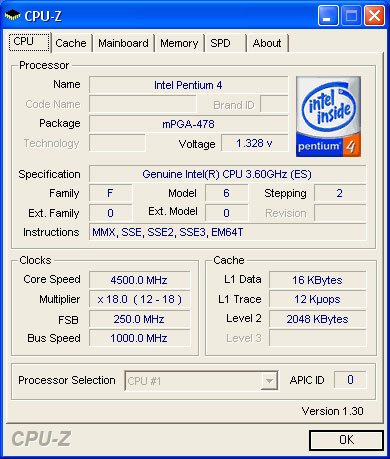
Next up was the dual-core Presler, which ran at a stock speed of 3.40GHz at 1.300V. Without increasing the core voltage at all, we couldn't break 3.5GHz on our Presler sample, so we went straight to bumping up the voltage. At 1.3625V, we managed to get Presler up to 4.25GHz (250MHz x 17.0), which was a fairly reasonable boost. The best overclocks that we have seen on a Smithfield based Pentium D have taken the chip up to 3.9GHz, so breaking 4.0GHz on a dual core Pentium D is pretty impressive (especially with twice the cache).
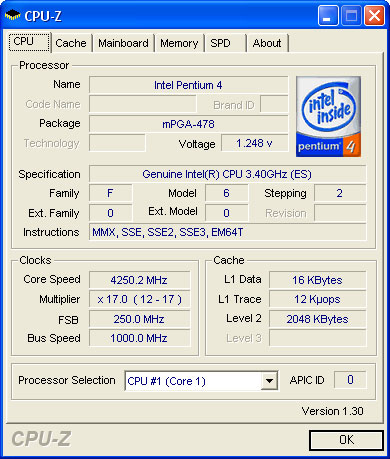
Power Consumption of Intel's 65nm Processors
Other than poor performance, extremely high power consumption has been a frequently voiced criticism about Intel's Prescott. Thanks to its 31+ stage pipeline and high clock speeds, the Pentium 4 and Pentium D tend to draw quite a bit of power. How does 65nm change the power consumption landscape?
First up is Cedar Mill:
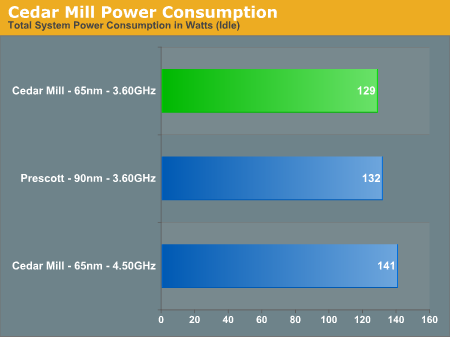
Next up, we loaded two threads of POV-ray's benchmark to fully load the CPUs and compare power consumption under load:
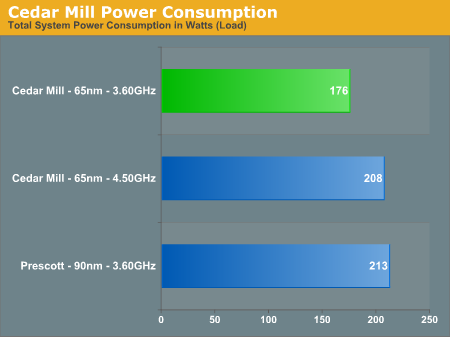
Next, we have Intel's dual core processors - Smithfield (90nm) and Presler (65nm):
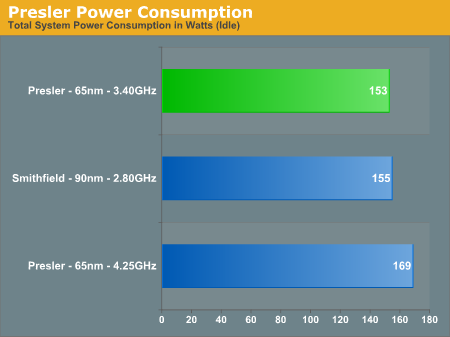

Final Words
Intel's move to 65nm is very much on track; today, we are able to test working samples at shipping clock speeds of Intel's 65nm Pentium 4 and Pentium D processors. This means that quite a bit of work has taken place between two IDFs ago where we first saw Presler at 2.0GHz and today when we're able to overclock the core to 4.25GHz with minimal effort.
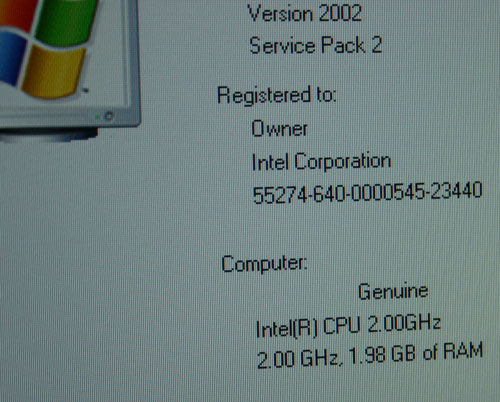
Presler was running at only 2.0GHz less than a year ago.
The new cores do definitely overclock much better than their predecessors, and they will allow any serious overclocker to reach speeds greater than 4.0GHz effortlessly. Most exciting to us was the 4.25GHz overclock that we saw on Presler, as a 4.25GHz Pentium D will truly be a formidable opponent to AMD's Athlon 64 X2. Cedar Mill offered reasonable overclocking headroom as well, but we would have liked to see a 5.0GHz overclock on standard air cooling, given that reaching 4.0GHz is possible today on Prescott.
The reduction in power consumption is impressive, but still not enough to give Intel an advantage over AMD, which makes things better, but hardly fixes the problem in our opinion. Unfortunately, we will have to wait for Intel's next-generation processors for a true competitor to AMD's low power Athlon 64s.
We have concluded this preview with one major unanswered question: how well does Intel's Presler perform compared to Smithfield, given that each core in Presler has twice the L2 cache of those in Smithfield? With our curiosities piqued, it won't be long before we try to answer that question...







